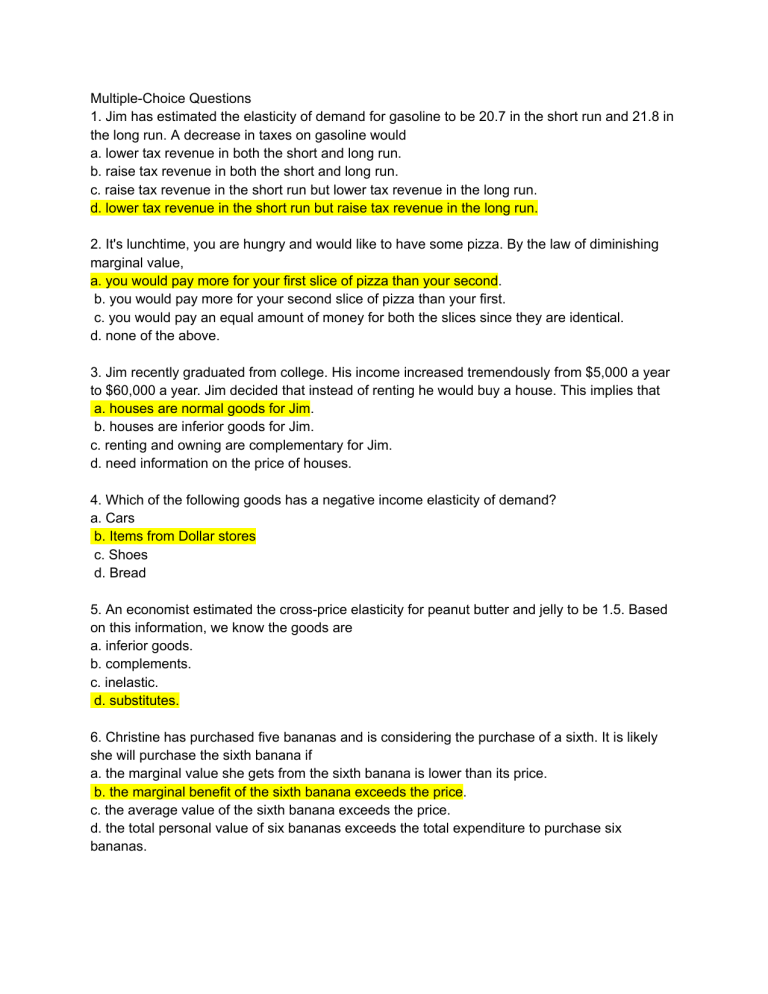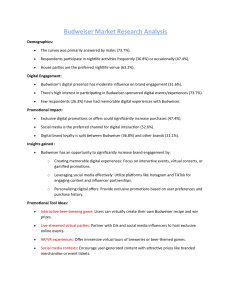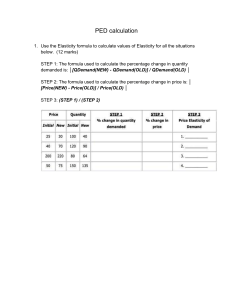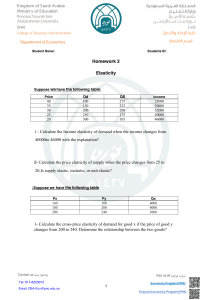
Multiple-Choice Questions 1. Jim has estimated the elasticity of demand for gasoline to be 20.7 in the short run and 21.8 in the long run. A decrease in taxes on gasoline would a. lower tax revenue in both the short and long run. b. raise tax revenue in both the short and long run. c. raise tax revenue in the short run but lower tax revenue in the long run. d. lower tax revenue in the short run but raise tax revenue in the long run. 2. It's lunchtime, you are hungry and would like to have some pizza. By the law of diminishing marginal value, a. you would pay more for your first slice of pizza than your second. b. you would pay more for your second slice of pizza than your first. c. you would pay an equal amount of money for both the slices since they are identical. d. none of the above. 3. Jim recently graduated from college. His income increased tremendously from $5,000 a year to $60,000 a year. Jim decided that instead of renting he would buy a house. This implies that a. houses are normal goods for Jim. b. houses are inferior goods for Jim. c. renting and owning are complementary for Jim. d. need information on the price of houses. 4. Which of the following goods has a negative income elasticity of demand? a. Cars b. Items from Dollar stores c. Shoes d. Bread 5. An economist estimated the cross-price elasticity for peanut butter and jelly to be 1.5. Based on this information, we know the goods are a. inferior goods. b. complements. c. inelastic. d. substitutes. 6. Christine has purchased five bananas and is considering the purchase of a sixth. It is likely she will purchase the sixth banana if a. the marginal value she gets from the sixth banana is lower than its price. b. the marginal benefit of the sixth banana exceeds the price. c. the average value of the sixth banana exceeds the price. d. the total personal value of six bananas exceeds the total expenditure to purchase six bananas. 7. Buyers consider Marlboro cigarettes and Budweiser beer to be complements. If Marlboro just increased its prices, what would you expect to occur in the Budweiser market? a. Demand would rise, and Budweiser would reduce prices. b. Demand would fall, and Budweiser would reduce prices. c. Demand would fall, and Budweiser would increase prices. d. Demand would rise, and Budweiser would increase supply 8. Which of the following is the reason for the existence of consumer surplus? a. Consumers can purchase goods that they “want” in addition to what they “need.” b. Consumers can occasionally purchase products for less than their production cost. c. Some consumers receive temporary discounts that result in below-market prices. d. Some consumers are willing to pay more than the price. 9. A bakery currently sells chocolate chip cookies at a price of $16/dozen. The MC is $8/dozen. The cookies are becoming more popular with customers, so the bakery owner is considering raising the price to $20/dozen. What percentage of customers must be retained to ensure that the price increase is profitable? a. 28.0% b. 33.3% c. 66.6% d. 72.0% 10. Suppose your firm adopts a technology that allows you to increase your output by 15%. If the elasticity of demand is 23, how should you adjust the price if you want to sell all of your output? a. 5% lower b. 0.5% lower c. 15% higher d. 15% lower Individual Problems 6-2 Increasing Movie Ticket Prices To conduct an experiment, AMC increased movie ticket prices from $9.00 to $10.00 and measured the change in ticket sales. Using the data over the following month, they concluded that the increase was profitable. However, over the subsequent months, they changed their minds and discontinued the experiment. How did the timing affect their conclusion about the profitability of increasing prices? When AMC increased the price of movie tickets from nine dollars to ten. They observed people were still buying the tickets which increased the revenue in a short period of time for the firm. which seems to be a short-term factor element by which the company gets influenced and also plays a significant role in determining the profitability at the beginning. Nevertheless, after a few months, they saw a dwindle in demand, which may be caused by the higher prices and high competition. As they were making less profit they stopped experimenting. The company may have realized that the profit they were getting at first was sustainable at all. They may have to decide on the basis of the short-term and long-term inference of the pricing strategy.



